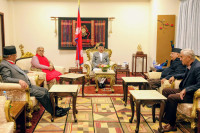Opinion
Double whammy
International humanitarian assistance poured into Nepal immediately after the 2015 Gorkha Earthquake following a government appeal for help.
Shrijan Bahadur Malla
International humanitarian assistance poured into Nepal immediately after the 2015 Gorkha Earthquake following a government appeal for help. It was indeed one of the remarkable multinational disaster response operations in which rescue teams from 34 countries rushed to the devastated sites to help survivors. Would there have been a similar instantaneous response if the earthquake had occurred a decade ago during the Maoist conflict?
Humanitarian principles
Management of disaster during peace and war is a different thing altogether. During war, it is more complicated because government forces, which are a major component of disaster response, are parties to the conflict. Therefore, humanitarian agencies are reluctant to work with the armed forces because of their principles of neutrality, impartiality and humanity besides security issues. The Guidelines on the Use of Military and Civil Defence Assets to Support United Nations Humanitarian Activities in Complex Emergencies (MCDA Guidelines 2003) clearly prohibit the use of armed forces engaged in conflict management in disaster response operations. Unarmed troops should be used in rescue operations so that humanitarian principles can be maintained.
There are instances where states have rejected offers of international humanitarian assistance although the need was paramount. In 2004, the Indonesian government refused to allow international humanitarian agencies to go to Aceh province after the tsunami even though help was badly needed because an armed
conflict was going on between government forces and rebel groups in the area. Likewise, in Myanmar in 2008, international humanitarian agencies were denied access after Cyclone Nargis.
In 2010, Pakistan restricted the movement of humanitarian agencies in Khyber Pakhtunkhwa and Baluchistan following a flood disaster citing security reasons since the Pakistan army was fighting local armed rebels. In 2013 in the Philippines, humanitarian agencies weren’t allowed to go to Samar and Leyte provinces during Typhoon Haiyan citing security reasons. Hence, it is obvious that generating effective cooperation for disaster response among stakeholders is very complex in such situations while, at the same time, the suffering of victims grows severalfold. This is because the actors involved are driven by different cultures, understandings and guiding principles.
Since Nepal’s overall disaster management mechanism is at a rudimentary stage, there is no such particular legal provision to manage natural disasters during armed conflict. The Natural Calamity Relief Act 1982, Local Self-Governance Act 1999, National Strategy for Disaster Risk Management 2009 and National Disaster Response Framework 2013 are the existing legislative frameworks governing disaster management regardless of whether there is war or peace.
From the international perspective too, besides non-binding rules like the MCDA Guidelines, there is no clear binding law on disaster management during armed conflict. It is believed that international humanitarian law prevails as a matter of lex specialis to guide disaster response. Since Nepal is a signatory to the Geneva Convention, it is obliged to comply with this law. In addition to the constitution, there are various domestic legal provisions, such as the National Human Rights Commission Act 2012 and Civil Rights Act 1995, and the international conventions and treaties that Nepal has ratified, such as the International Covenant on Civil and Political Rights (ICCPR). The government is obliged to protect the rights of the citizens and their privileges and wellbeing should a disaster occur during an armed conflict.
Civil defence mechanism
Since Nepal doesn’t have an effective civil defence mechanism as described by the Geneva Convention 1977, security organisations, especially the Nepal Army, and the existing national and international humanitarian agencies have to respond when disaster occurs. The scale of the international response after the Gorkha Earthquake shows that things are not complicated during peacetime, but what should be done during an armed conflict remains a question.
Against this backdrop, the government should not delay ratifying the Disaster Management Act which is pending in Parliament. This will render strategic guidelines along with a policy and legal framework to strengthen institutional and national commitment with regard to disaster management. Second, the government should invest more resources to establish an effective civil defence mechanism besides building resilience capabilities among local communities. That will definitely reduce the level of dependency on foreign assistance.
Third, the government should not hesitate to enhance the competencies of the security forces. It should also create standardised urban search and rescue (USAR) teams. If the Nepal Army had possessed enough helicopters and USAR teams during the Gorkha earthquake, Nepal would not have had to take than more than half of the assistance received. Similarly, their communication and medical facilities also require continuous advancement.
Lastly, the government should not delay devising an appropriate legislative framework to ensure effective disaster response during armed conflict. The framework should clearly state how to establish effective coordination, share information, manage resources, render security and provide legal provisions to various stakeholders. Towards this end, a comprehensive platform needs to be established where government authorities, national and international humanitarian agencies, security forces and civil societies can come together to talk.
The decade-long Maoist conflict and the Gorkha earthquake have taught many lessons to the country. One of them is the paramount need for humanitarian assistance in either case. The question remains: Will Nepal be able to endure a natural disaster in the midst of an armed conflict? The country is always prone to natural disasters and susceptible to armed conflict. The answer can be positive, but what is needed is thorough preparedness.
Malla is pursuing a PhD in disaster management at Kagawa University, Japan




 7.12°C Kathmandu
7.12°C Kathmandu











